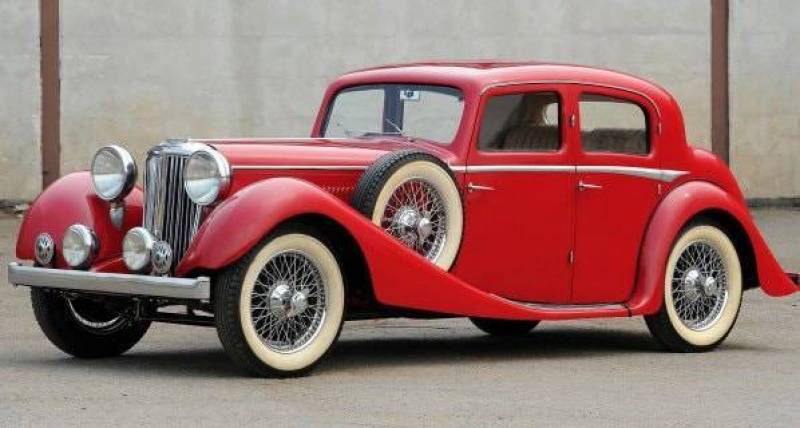SS Cars SS Jaguar Saloon
Production: 1935 - 1940
Production Type: Mass Production
Produced: 12793
The SS Jaguar Saloon was a series of Jaguar Saloon-style cars with three different engines that were produced from 1935 to 1940.

About SS Cars SS Jaguar Saloon
SS Jaguar Saloon was announced in 1935 at the Mayfair Hotel, about 2 weeks before the opening of the famous London Motor Show. Initially, it was introduced with 1.5 and 2.5 liter engines, and in 1938 a model with a 3.5 liter engine was added.
In 1938, production switched to a metal all-welded body instead of wooden frames with attached metal panels. Also, the spare wheel has moved from the wing to a special compartment in the trunk.
Approximately 12,793 SS Jaguar Saloons were built from 1935 to 1940 with various engines. Among them: Jaguar 1.5 Liter Saloon ~6,692, Jaguar 2.5 Liter Saloon ~5030, Jaguar 3.5 Liter Saloon ~1,071. from 1939 Drop Head Coupe body chassis began to be produced under Saloon body chassis numbers. Again, there are far fewer Drop Head Coupe cars made, and out of nearly 13,000 Saloon bodies, the number of DHCs from 1939-1940 is estimated to be around 100-200 units.
SS Cars SS Jaguar Saloon Overview
Although the SS Jaguar Saloon was produced with all three engine types, only the 1.5 liter (1775.8 cc) engine presented in this article. You can learn about the 2.5 liter engine in the SS Jaguar Open Tourer article, and about the 3.5 liter engine in the SS jaguar Drop Head Coupe article.
SS Cars SS Jaguar Saloon Technical Specification
Engine: Four-cylinder, bore and stroke 73×106 mm, 1775-8 c.s. (13.23 hp) - £10 10s 0d. SU carburetor, overhead valves, chrome iron cylinder head, detachable head, aluminum pistons, 3 bearing crankshaft, light alloy connecting rods, Tecalemit oil filter, thermostatic pump cooling, forced lubrication system, submersible oil pump, ignition coils.
Frame: Rigid high strength frame.
Suspension: Lead-coated semi-elliptical leaf springs. Luvax dampers.
Transmission: Synchronized four-speed mechanics. Gear ratios: 1at - 19.18, 2at - 11.8, 3at - 7.06, top - 4.86.
Gas Equipment: Mechanical fuel pump and 14 gallon gas tank.
Electrical equipment: Lucas de Luxe with 12 volt equipment. Large main lights, reversing light and brake lights, two interior lights, double horn, electric wipers.
Wheels and tires: 18" Dunlop rims with Dunlop 90 5.25x18 tires. Spare wheel in a special compartment (under the toolbox) at the rear of the car (until 1938 the spare wheel was installed in the fender).
Jacking: Easily done with special jacks.
Brakes: Girling brake system with Millenite drums.
Dashboard: Speedometer, speed gauge, cigarette lighter, ammeter, fuel gauge, oil gauge, temperature gauge, emergency light switch.
Controls: Worm-driven Burman Douglass. Bluemel steering wheel.
Seats: All seats in Vaumol and Dunlopillo finishes. Front seats with Leveroll rails. Folding armrest at the back.
Finishes: "Vaumol" and "Dunlopillo". Floor covering with felt backing.
Trunk: Ample luggage space is provided in the large rear locker, the lid of which can be lowered to accommodate additional luggage.
Dimensions: Wheelbase - 9′ 4 1/2″, track width – 4′ 7″. Overall length - 14’ 5" Width - 5’ 5 1/2" Height - 5’ 0" Ground clearance - 7" Weight - 25 cwt.
Colors: Body/Trim: Olive/Beige, Olive; Burgundy/Beige, Burgundy; Green suede/Green suede; Dark Blue/Beige, Dark Blue; Ivory/Red, Green Suede, Beige; Green Ash/Green Suede; Birch/Red, Grey-black; Marine Grey/Red, Grey-Black; Lavender Grey/Blue, Green Suede, Red; Gun Grey/Grey Black, Red; Honeysuckle/Beige, Red; Black/Brown, Beige, Olive, Red, Black Grey, Dark Beige. Non-standard color - £5. Pearl mother-of-pearl and white - £ 10. Special coloring of wheels - 1 £ 1s 0d. Non-standard upholstery coloring - 2 £ 10s 0d.
Price: 1.5 liters - £298, 2.5 liters - £395, 3.5 liters - £445.